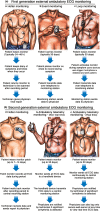2017 ISHNE-HRS expert consensus statement on ambulatory ECG and external cardiac monitoring/telemetry
- PMID: 28480632
- PMCID: PMC6931745
- DOI: 10.1111/anec.12447
2017 ISHNE-HRS expert consensus statement on ambulatory ECG and external cardiac monitoring/telemetry
Abstract
Ambulatory ECG (AECG) is very commonly employed in a variety of clinical contexts to detect cardiac arrhythmias and/or arrhythmia patterns which are not readily obtained from the standard ECG. Accurate and timely characterization of arrhythmias is crucial to direct therapies that can have an important impact on diagnosis, prognosis or patient symptom status. The rhythm information derived from the large variety of AECG recording systems can often lead to appropriate and patient-specific medical and interventional management. The details in this document provide background and framework from which to apply AECG techniques in clinical practice, as well as clinical research.
Keywords: Holter; ambulatory ECG monitoring; event monitor; loop recorder; telemetry; transtelephonic.
© 2017 International Society for Holter and Noninvasive Electrocardiology, Heart Rhythm Society, and Wiley Periodicals, Inc.
Figures




References
-
- Ackermans, P. A. , Solosko, T. A. , Spencer, E. C. , Gehman, S. E. , Nammi, K. , Engel, J. , & Russell, J. K. (2012). A user‐friendly integrated monitor‐adhesive patch for long‐term ambulatory electrocardiogram monitoring. Journal of Electrocardiology, 45, 148–153. - PubMed
-
- Adabag, A. S. , Casey, S. A. , Kuskowski, M. A. , Zenovich, A. G. , & Maron, B. J. (2005). Spectrum and prognostic significance of arrhythmias on ambulatory Holter electrocardiogram in hypertrophic cardiomyopathy. Journal of the American College of Cardiology, 45, 697–704. - PubMed
-
- Adabag, A. S. , Maron, B. J. , Appelbaum, E. , Harrigan, C. J. , Buros, J. L. , Gibson, C. M. , … Maron, M. S. (2008). Occurrence and frequency of arrhythmias in hypertrophic cardiomyopathy in relation to delayed enhancement on cardiovascular magnetic resonance. Journal of the American College of Cardiology, 51, 1369–1374. - PubMed
-
- Alboni, P. , Botto, G. , Baldi, N. , Luzi, M. , Russo, V. , Gianfranchi, L. , … Gaggioli, G. (2004). Outpatient treatment of recent‐onset atrial fibrillation with the “Pill‐in‐the‐Pocket” approach. New England Journal of Medicine, 351, 2383–2391. - PubMed
Publication types
MeSH terms
LinkOut - more resources
Full Text Sources
Other Literature Sources
Medical

